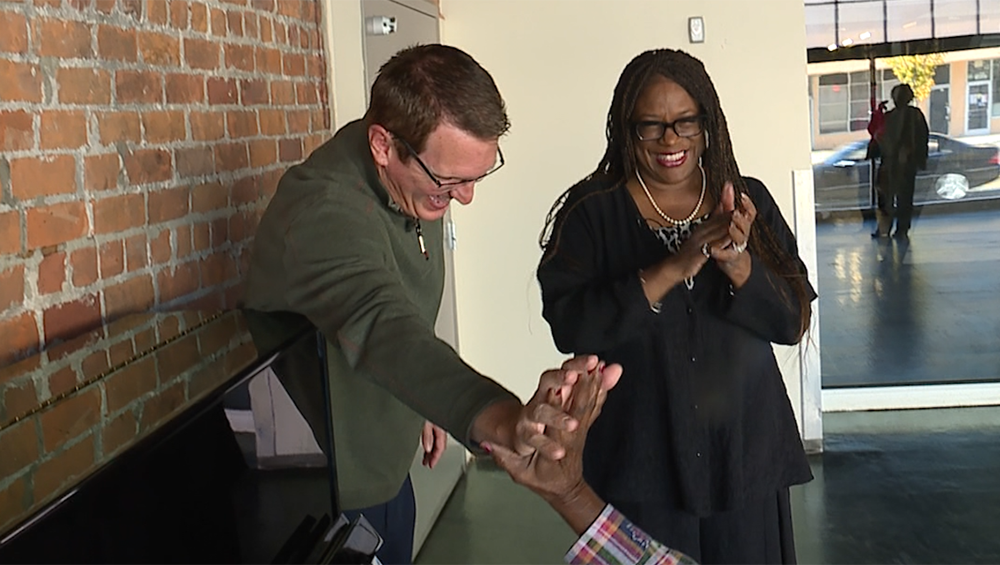
TVN Focus | Scripps Took An Early Lead On Diversity Efforts

Black Lives Matter protests across the nation have prompted many U.S. companies — including broadcasters — to reappraise their own efforts toward diversity in recent weeks. But the E.W. Scripps Co. began looking at itself in the mirror two years ago, and even then had problems with what it saw.
“Over the last couple of years as we have become a bigger company, the communities we are doing business in are different and diverse,” says Brian Lawlor, president of local media. “It has become obvious to us that one size doesn’t fit all and that we have got to make sure every one of our local stations represents their local communities.”
What followed was a top-down mandate to reassess equity, diversity and inclusion in all aspects of Scripps’ DNA. That started with the C-suite and extended to staffing at each of its stations. Executives and management looked hard at how gender, race, ethnicity and sexuality was represented both behind and in front of the cameras at its news operations.
Where Scripps found uniformity among its employees, it began a concerted effort to diversify. Where it found bias in its news, it started looking at the conventions it practiced that perpetuated it.
“Part of it is content,” Lawlor says. “Part of it is making sure that we are hiring a diverse and inclusive workforce. Part is training we have to help people understand implicit bias and the importance and benefits of diversity. Part is setting KPIs for each station to grow our diversity.”
Framing A Diversity Strategy
Among Scripps’ first major moves was the promotion of Chief Diversity Officer Danyelle Wright in April 2018. Wright, who has a bifurcated title of VP of employment and labor law at the company, reports to both its general counsel and to the company’s senior leadership team including President-CEO Adam Symson. She says Symson’s commitment was crucial to getting the initiative substantively off the ground.
“You have to have buy-in from the C-suite,” Wright says. “It has to be from top leadership down. If it’s not endorsed on high, then nothing will ever change.”

WXYZ Anchor Dave LewAllen (l) talks with one of Detroit’s change makers in a weekly “Person of the Week” segment.
Symson is unambiguous in that endorsement. “First of all, it is the right thing to do,” he says. “Second, I believe it can be a competitive advantage from a business standpoint. Before too long, this will be a majority minority country, and so merely from a perspective of better coverage of our audience and a better local and national business perspective, it only makes sense for us to ensure that we better reflect the demographics of this country, which this industry has not done historically.”
According to a 2019 RTDNA survey, the industry is improving somewhat. Network affiliates had 22.8% people of color overall among their employees, up 1.4% from the previous year. Stations in the South and West had more diversity than the Northeast and Midwest, which trailed even further behind.
News directors of color saw their best three years in 2016, 2018 and 2019 according to the survey, with Hispanic news directors seeing a 2.3% jump in 2019 while all other groups lost representation. GMs of color rose 1.6 overall to just over 10%, RTDNA found.
Women in the local TV news workforce grew to 44.9% with a 0.5% increase. Female news directors in 2019 were at 35.3%, while women GMs hit a 25-year high at 23.4%. In all cases, it’s still a far cry from parity.
Michelle Duke, president of the NAB Leadership Foundation, distills the ongoing problem. “We have eyes, and we can look around conferences, conventions and so forth and notice that there is a lack of diversity,” she says.
At Scripps, Wright’s tenure began with a listening tour to assess the company’s state of diversity and then the task of devising an enterprise strategy for the entire company to serve as a foundational premise for each of its divisions. That strategy took on a five-year frame with four focal points for improvement:
- Accelerating racial and ethnic diversity.
- Insuring 50/50 gender representation.
- Creating an inclusive culture for LGBTQ+ employees.
- Becoming a leading media employer for reservists and transitioning veterans.
A Committee Approach
“This starts with an intentional plan and the acknowledgement that you can be better,” Lawlor says. “This is not HR coming to us saying you have got a problem, and let’s push a strategy on you. This was us through our normal course of business seeing that there are opportunities to better serve our community and solving these together.”
Lawlor says Scripps’ approach on the local media corporate level was to tackle the issue by committee with the heads of news, sales and HR all on board. This structure has been mirrored to some extent at each station, where priorities have been identified and engaged on a market-by-market basis to address where the company is falling short of representing its demographics.
Addressing a lack of diversity on air is the most visible solution to the problem, Lawlor says, but the effort needs to extend across each facet of the local operation. “It’s important that we find a representative business and sales force who open up doors to us in communities,” he says. “People are comfortable doing business with people who look like them, who share ideals with them.”
On the recruitment front, Candace Anderson, VP human resources, local media, has long cultivated partnerships with organizations like the National Association of Black Journalists and National Association of Hispanic Journalists, along with forging direct relationships with individual universities and even high schools to find potential hires. “We have created different pipelines of talent,” she says.
But as Wright points out, recruitment is only one facet of ensuring diversity, and the entire employee life cycle needs to be taken into account. “Do we do a good job of welcoming them so that they feel they want to be here and stay here?” she says. “Are they getting access to opportunities so they can have visibility to middle management upwards to senior management teams? It’s not just getting folks in the door.”
Tackling Diversity Station By Station
One of Scripps’ first initiatives at each individual station was diversity and inclusion training. For Mike Canan, senior director of local content at WCPO Cincinnati, that alone had a transformative effect.
“The training we went through was really eye-opening,” he says. “It caused people to think about their own structural biases in different ways. It started conversations in our newsroom that I don’t think would’ve happened otherwise — deep, ethical and moral conversations about how our journalism and our actions as a whole might be perceived by or impact our community.”

WXYZ Detroit Meteorologist Dave Rexroth shines a light on the Franklin Wright Settlement — a nonprofit helping Detroit communities in a “7 In Your Neighborhood” segment.
Journalistically, that translated into one major concrete change at WCPO: The station has stopped using mugshots with most of its crime stories.
For Canan, the rationale behind that move is extensive. Mug shots carry a presumption of guilt, have a damning, enduring effect on the subject and “feel like a punishment handed down by the media.” He says they inordinately swing toward people of color and then impact viewers’ implicit biases.
“Ultimately, the mug shot itself is not a compelling visual,” Canan says. “It is a terrible picture and it adds very little to the story.”
Coupled with the fact that many mug shots take on a kind of entertainment value — their subjects often disheveled, on drugs, heavily tattooed or distraught-looking, and “that doesn’t seem like very ethical journalism,” he says.
Canan says WCPO’s staffers came out of their initial training and immediately formed five committees to engage diversification at a strategic level. Three of those committees were newsroom-specific and took on a range of efforts, including evaluating all of the station’s crime policies and procedures of which the mug shots decision was a product.
Another committee was designed to help solicit more news from different facets of the community, including neighborhoods that typically only turn up in coverage when a crime has been committed there. Canan says a cross-section of newsroom personnel will now make monthly visits to different areas of their markets with a remit to emerge with new sources and story ideas.
Mike Murri, VP-GM of WXYZ Detroit, is taking a similar tack with the station’s “Seven in Your Neighborhood” initiative. “That is us being extremely intentional and deliberate about getting our people out every single week in each and every neighborhood in our metro Detroit area,” he says.
That includes particularly concerted outreach in the city’s rich Arab-American community. “We have the leaders from the community in our building to talk with our team, and we are out in the community talking with different leaders,” he says.
WCPO’s Canan says yet another of his station’s committees is reexamining community outreach efforts to make sure events the station sponsors are more diverse. The group will look to ensure donations are reaching a greater array of community beneficiaries and the events the station’s anchors emcee aren’t just the usual circuit of black tie galas and major philanthropies, but rather “that we are reaching out and truly touching a larger percentage of our community.”
At Nashville’s WTVF, VP-GM Lyn Plantinga also launched into a more intentional diversity effort after an impactful training. Like WCPO, one of the station’s subsequent efforts focused on the images it was using on camera and on its digital platforms.
“We didn’t feel the images we were using reflected a diverse community,” Plantinga says. “We eliminated a lot of what I would call the stock images you use online in conjunction with a story and made some changes that were more inclusive.”
Ditto the sources WTVF’s reporters were turning to for their stories. “We have a Rolodex that we built that is designed to give us experts in all different kinds of areas who are women and people of color,” Plantinga says. “We are no longer calling the same person over and over again. We can turn to multiple people who don’t all think, look and sound the same.”
Plantinga, who began her career as an unpaid intern at the station and has risen to its helm, sees progress in its more diverse ranks. “It looks a whole lot different today than it did when I rolled in here 30 years ago, and I am proud of that,” she says. “It’s clear to me we have work to do, but when people are in a room making coverage decisions, there are a lot of different types of people and voices in those rooms.”
Her voice, of course, is one of them.
Scripps hasn’t shared its specific hiring KPIs for the overall initiative but allows that currently its newsroom staffing is 27% people of color, trending just over the RTDNA’s industry-wide numbers. Women are trending just below that benchmark at 43%, according to HR VP Anderson, who concedes, as with every other source for this story, that there’s much work to be done.
The current U.S. protests have underscored such disparities that have turned toxic and finally begun to prompt long-needed changes. On this front, Scripps can rightly say it was ahead of a moment many would say was too long in coming.
“Everything that is happening right now just points to the fact that the work we were doing is needed and important,” Anderson says. “That is going to be part of the change in helping us go forward.”
Editor’s note: A previous version of the story stated that Danyelle Wright was hired as chief diversity officer in 2018. She was promoted from her previous position as employment attorney with the company.
































Comments (0)